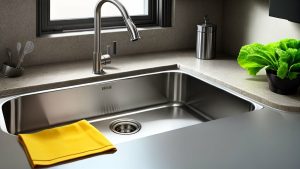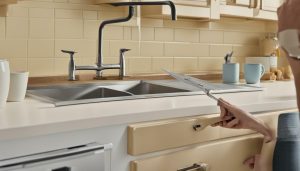If you’re looking to upgrade your kitchen with a custom piece of furniture, why not try creating your own kitchen island? A kitchen island can add valuable counter space, storage, and even seating to your kitchen. And the best part? You can tailor it to your specific style and needs.
In this article, we’ll provide a step-by-step guide on how to create your own kitchen island, from planning and designing to finishing touches and maintenance. Whether you’re a seasoned DIY-er or a beginner, we’ll provide tips and tricks to ensure your kitchen island project is a success.
Key Takeaways:
- Creating a kitchen island can add valuable counter space, storage, and seating to your kitchen.
- You can tailor your kitchen island to your specific style and needs.
- Follow our step-by-step guide to plan, design, and build your own kitchen island.
- Remember to prioritize safety and consult professionals when necessary.
- Proper maintenance and care can ensure the longevity of your kitchen island.
Planning and Designing Your Kitchen Island
Creating your own kitchen island starts with careful planning and designing. This stage requires you to determine the size, shape, and style of your island according to your kitchen space and your personal preferences. Here are some kitchen island design ideas and tips to help you get started:
Consider the Functionality of Your Kitchen Island
Before you start designing, it’s important to define the purpose of your kitchen island. Will it serve as a food prep area, a cooking station, a dining table, or a storage unit? Knowing the main function of your island will help you decide on the layout and features that you need.
Choose the Shape and Size of Your Kitchen Island
The shape and size of your island will depend on the available space in your kitchen and the purpose of your island. A rectangular or square island fits well in most kitchens and provides ample space for food prep and storage. A circular or oval island creates a more unique and aesthetically pleasing look, but may be less functional for cooking and storage. Consider the traffic flow in your kitchen and leave enough space around your island to move freely.
Select the Materials for Your Kitchen Island
When it comes to DIY kitchen islands, there are a variety of materials to choose from. Wood, metal, granite, and marble are popular options for countertops, while hardwood and plywood are commonly used for the base. Consider the durability, maintenance, and cost of each material before making your final decision.
Customize Your Kitchen Island
A custom kitchen island should reflect your personal style and enhance the overall look of your kitchen. Add some personality and functionality to your island by incorporating features such as a built-in wine rack, a sink, a stovetop, or a seating area. Don’t be afraid to get creative and think outside the box!
Gathering Materials and Tools
Before you start building your DIY kitchen island, you will need to gather all the necessary materials and tools. Here is a comprehensive list of items you will need:
| Materials | Tools |
|---|---|
| Wood boards | Saw |
| Countertop material (granite, marble, stainless steel, etc.) | Drill |
| Cabinets and hardware | Hammer |
| Screws, bolts, and nails | Screwdriver |
| Wood glue | Tape measure |
| Sandpaper | Level |
| Paint or stain | Paintbrush |
When choosing materials, consider factors such as durability, style, and budget. Selecting high-quality materials will ensure that your kitchen island is both sturdy and visually appealing.
Make sure you have all the necessary tools on hand as well. Having the right tools will make the construction process smoother and more efficient.
It’s also a good idea to set up a well-ventilated workspace before you begin building. This could be a garage or outdoor area where you can spread out your materials and equipment without worrying about making a mess.
Measuring and Preparing the Space
Before you begin building your kitchen island, it’s essential to measure and prepare the space where it will be placed. Follow these steps:
- Measure the length and width of the available space for the island. The island should be proportional to the size of your kitchen and your needs.
- Determine the height of the island. Standard counter height is around 36 inches, but you may want a customized height to accommodate your needs.
- Mark the floor where the island will be placed, using tape or chalk. This will give you a visual idea of the size and placement of the island.
- Consider the flow of traffic in your kitchen. Make sure there is enough space for people to move around the island comfortably.
- Check for any obstacles, such as electrical outlets, plumbing, or vents, that may interfere with the placement of the island.
Once you have measured and prepared the space, you can move on to building the base of your kitchen island.
Building the Base
Once you have gathered all the necessary materials and tools, it’s time to start building the base of your kitchen island. Follow these kitchen island construction tips to ensure a sturdy and well-constructed base.
Step 1: Cut the Lumber
Using a saw, cut the lumber according to your kitchen island plans. Make sure to measure accurately to ensure a proper fit. For added strength, use corner braces at each joint.
Step 2: Assemble the Base
Using wood screws, assemble the base of your kitchen island. Make sure to pre-drill all screw holes to prevent splitting. It’s important to double-check that everything is level and square before proceeding.
Step 3: Add the Legs
Attach the legs to the base using metal brackets and screws. This will keep the legs securely in place and provide added stability.
Step 4: Install the Casters
If you plan to make your kitchen island portable, now is the time to install the casters. Attach the casters to the bottom of the legs using screws. Make sure the casters can support the weight of the island and are securely attached.
Step 5: Sand and Paint or Stain
Once the base is constructed, sand any rough edges and apply paint or stain according to your personal preference. Make sure to let the paint or stain fully dry before proceeding to the next step.
By following these kitchen island building tips, you can ensure a sturdy and well-constructed base that will support your kitchen island for years to come.
Installing Countertops and Cabinets
Now that the base is complete, it’s time to install the countertops and cabinets on your kitchen island. Here are some tips to ensure a successful installation:
Installing Countertops
The first step in installing your countertops is to measure and cut them to the appropriate size. Depending on the material you choose, this may involve using a saw or special cutting tools.
Once your countertops are cut, you can secure them to the base using screws or adhesive. Make sure to line up the edges and corners correctly and check for levelness. If you’re using a heavier material like granite, you may need to use additional supports to ensure stability.
Remember to seal your countertops to prevent staining and damage over time. Follow the manufacturer’s instructions for proper cleaning and maintenance.
Installing Cabinets
If you’ve decided to incorporate cabinets into your kitchen island, you’ll need to measure and cut them to fit your design. You can also purchase pre-made cabinets and modify them as needed.
Once you have your cabinets, it’s time to attach them to the base. Use screws to secure the cabinets to the frame, making sure they are level and flush with the countertops. You may also want to add additional bracing to support the weight of the cabinets and their contents.
Finally, install the cabinet doors and drawers and add any hardware or accessories you desire. This is the perfect opportunity to add some personalized touches to your custom kitchen island.
By following these tips, you can ensure a successful installation of your countertops and cabinets on your kitchen island. Remember to take your time and double-check your measurements and levelness for a professional-looking finish.
Adding Storage and Functionality
One of the most significant advantages of creating your own kitchen island is the ability to customize it to meet your specific needs. Adding storage and functionality can significantly increase the island’s usefulness and make your time spent in the kitchen more efficient.
Drawers and Shelves
The addition of drawers and shelves is a popular way to incorporate storage space into your kitchen island. When constructing your drawers, ensure that they are deep enough to hold larger kitchen utensils. Use drawer slides that are strong enough to support heavier items like pots and pans. Shelves can be placed on one side of the island to store cookbooks or small appliances. Installing wire baskets on the side of the island can be a convenient way to store fruits and vegetables.
Cabinet Space
Another option to consider is incorporating cabinet space into your island. Use standard cabinets or opt for custom-made cabinets that match your kitchen’s design. Cabinets can be used to store larger items such as baking dishes and small appliances. When positioning cabinets on your island, ensure that there is enough clearance for the doors to open fully.
Other Additions
Other functional additions to consider when constructing your own kitchen island include a built-in cutting board or a sink for food preparation. If you plan to use your island for food preparation, ensure that you have adequate counter space and that the countertops are made from a durable material that can withstand everyday wear and tear.
Adding storage and functionality to your kitchen island requires careful planning and attention to detail. Consider your specific needs and how you will use the island to determine which additions will be most beneficial for you.
Finishing Touches and Customization
Now that the hard work of constructing your kitchen island is complete, it’s time to add those special finishing touches that will turn your island into a standout piece in your home. Customization is key to make your kitchen island unique and suited to your everyday needs. Below are some ideas to help you get started.
Adding Personal Touches
Add personal touches to your kitchen island to make it truly unique. One great way to do this is by adding a custom message or logo to the side of your island using stencils and paint. You could also incorporate a chalkboard panel for a fun and functional touch, or add a built-in cookbook stand that matches your island’s finish.
Lighting
Lighting can make a big difference in the overall look and feel of your kitchen island. Consider adding task lighting under the cabinets or above the island to provide ample light for cooking or reading recipes. You could also incorporate pendant lights for a stylish touch that will add both ambiance and functionality to your space.
Seating
If you have the space, adding seating to your kitchen island is a great way to create a casual dining spot. Incorporating comfortable stools or chairs will allow you to enjoy meals or entertain guests while cooking.
Storage Solutions
Maximize functionality by adding storage solutions to your island. You could incorporate a built-in wine rack, install pull-out drawers for extra storage, or create open shelving for displaying your favorite cookbooks and decor.
Remember, the customization options for your kitchen island are endless. Use these ideas as inspiration, and don’t be afraid to get creative and put your own personal touch on your island.
Wiring and Plumbing Considerations
When designing your custom kitchen island, you may want to incorporate electrical outlets, lighting fixtures, or plumbing features. However, it’s important to keep in mind some important wiring and plumbing considerations to ensure safety and effectiveness.
Electrical Wiring
First and foremost, when adding electrical outlets or fixtures to your kitchen island, you must comply with electrical codes and regulations. It’s recommended to hire a licensed electrician to handle any wiring work.
You must also ensure that the wiring and electrical components are properly protected from moisture and heat. Use waterproof outlet covers and select fixtures that are rated for kitchen use.
Plumbing Features
If you plan to incorporate a sink, dishwasher, or other plumbing feature into your kitchen island, it’s crucial to ensure proper drainage and ventilation. Consider the placement of your island in relation to existing plumbing lines, and hire a licensed plumber to handle any installation work.
You may also need to install a ventilation system, such as a range hood, in order to properly vent steam and odors from your cooking area.
Remember to always follow local codes and regulations when adding wiring or plumbing features to your kitchen island. Consult with professionals to ensure safety and functionality.
Applying the Final Coats and Finishes
Once you have completed constructing your kitchen island, the next step is to apply the final coats and finishes to protect and enhance its appearance. Here are some options and techniques to consider:
Paint or Stain
If you want a pop of color or a natural wood finish, paint or stain can be a great choice. Be sure to choose a durable, moisture-resistant option for kitchen use. Apply the paint or stain in thin, even coats, allowing each layer to dry completely before adding the next.
Sealant
A sealant can help protect your kitchen island from moisture and wear and tear. Choose a food-safe, water-resistant sealant and apply it in thin, even coats. Sand lightly between each layer for a smooth finish.
Polish
For a shiny, smooth finish, consider using a polishing product. This can help protect your kitchen island and enhance its natural beauty. Be sure to choose a product that is safe for the materials used in your island and apply it according to the instructions.
Touch Up
After your kitchen island is complete, be sure to touch up any areas that may need it. This includes sanding down rough spots, filling in gaps, and touching up any paint or stain as needed.
Remember, the final coats and finishes are important for protecting and enhancing your kitchen island. Take your time and choose the right products and techniques for the materials used in your island.
Section 11: Maintenance and Care Tips
After investing time and effort into building your own custom kitchen island, it’s important to properly maintain and care for it to ensure longevity. Here are some helpful tips:
- Regularly clean the surface of your kitchen island with a soft cloth and mild cleaning solution to avoid scratches or damage to the finish.
- Avoid using abrasive cleaners or scrubbers that can scratch or damage the countertop surface.
- If your kitchen island has a wood surface, consider using a cutting board to prevent scratches and food stains.
- Wipe up any spills or stains immediately to prevent them from seeping into the countertop or cabinet materials and causing damage.
- Inspect the hardware regularly and tighten any loose screws or fittings.
- Consider sealing any unfinished wood surfaces to protect against water damage and stains.
- Consult a professional if you notice any significant damage or issues with your kitchen island.
By following these maintenance and care tips, you can protect your investment and enjoy your custom kitchen island for years to come.
Conclusion
Congratulations on creating your very own kitchen island! By following the steps outlined in this guide, you have successfully built a functional and unique addition to your kitchen.
Remember to prioritize safety throughout the construction process and consult professionals if needed. With proper care and maintenance, your kitchen island will serve your family for years to come.
Thank you for following this step-by-step guide on how to create your own kitchen island. We hope it has been informative and helpful in your DIY journey. Happy building!
FAQ
Q: What are the key steps to create your own kitchen island?
A: The key steps to creating your own kitchen island include planning and designing, gathering materials and tools, measuring and preparing the space, building the base, installing countertops and cabinets, adding storage and functionality, applying finishing touches and customization, considering wiring and plumbing, applying final coats and finishes, and maintaining and caring for your island.
Q: What are some design ideas for a kitchen island?
A: Some design ideas for a kitchen island include incorporating different countertop materials, adding decorative elements such as corbels or legs, incorporating open shelving, including seating options, and customizing the shape and size to fit your space and needs.
Q: What materials and tools do I need to build a kitchen island?
A: The materials and tools you’ll need to build a kitchen island will vary depending on your design, but common items include lumber or cabinet-grade plywood, screws or nails, a saw, drill, measuring tape, level, and a sander. Additional materials such as countertops, cabinets, and hardware will also be required.
Q: How do I measure and prepare the space for a kitchen island?
A: To measure and prepare the space for a kitchen island, start by determining the desired size and shape of the island. Use measuring tape to mark the area where the island will be placed, ensuring there is enough clearance for walking and opening nearby cabinets and appliances. Prepare the floor by removing any existing flooring if necessary.
Q: What are some tips for building a sturdy kitchen island base?
A: Some tips for building a sturdy kitchen island base include using solid materials, such as hardwood or plywood, reinforcing joints with screws or brackets, ensuring the base is level and square, and adding extra support if needed. It is also important to consider the weight and load-bearing capacity of the base.
Q: What should I consider when installing countertops and cabinets?
A: When installing countertops and cabinets on your kitchen island, consider the material and style that best suits your design and needs. Take accurate measurements, ensure proper support for heavy countertops, and follow manufacturer guidelines for installation. It is also important to consider access to plumbing and electrical outlets if applicable.
Q: How can I add storage and functionality to my kitchen island?
A: There are several ways to add storage and functionality to your kitchen island. You can incorporate drawers, shelves, or cabinets for extra storage space. Consider adding features such as a built-in wine rack, spice storage, or a pull-out trash bin. Customizing your island to fit your specific needs will enhance its functionality.
Q: How can I customize and add finishing touches to my kitchen island?
A: To customize and add finishing touches to your kitchen island, consider adding decorative elements such as molding or trim, painting or staining the base and cabinets, installing unique hardware, or adding a decorative backsplash. You can also personalize the island with accessories and decor that match your kitchen style.
Q: What wiring and plumbing considerations should I keep in mind?
A: If you plan to incorporate electrical outlets or plumbing fixtures into your kitchen island, consult a professional to ensure proper installation and compliance with building codes. Consider the location of existing electrical and plumbing lines, and plan for access to power sources and drain lines.
Q: How do I apply final coats and finishes to my kitchen island?
A: When applying final coats and finishes to your kitchen island, start by sanding any rough surfaces and wiping away dust. Apply primer if necessary, followed by your chosen finish, such as paint or stain, using a brush or roller. Allow proper drying time between coats, and follow manufacturer instructions for best results.
Q: How do I maintain and care for my kitchen island?
A: To maintain and care for your kitchen island, regularly clean the surfaces using non-abrasive cleaners and a soft cloth. Avoid using harsh chemicals or abrasive scrubbers that can damage the finish. Wipe up spills promptly to prevent staining, and reapply protective coatings as needed. Follow any specific care instructions provided by the manufacturer.

It’s me, Amber Hayden, the heart and soul behind SagarmathaOnlineMedia.com. From a young age, I’ve been head over heels for everything home-related, from interior decor to gardening. I’m the type who can’t resist a well-crafted piece of furniture, and I firmly believe that a home isn’t complete without a pet or two. But it’s not just about creating pretty spaces for me. I’m all about making homes that tell a story reflecting the people living there. SagarmathaOnlineMedia.com is my way of sharing this passion with you. Whether you’re looking for tips to jazz up your living room, advice on pet care, or ideas to make your garden bloom, I’m here to help. So, let’s embark on this journey together and make your house a home!



